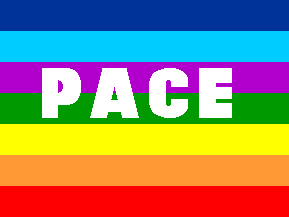 image by M. Schmöger, 2 August 2002
image by M. Schmöger, 2 August 2002Old version

FOTW beschäftigt sich mit der Wissenschaft der Vexillologie (Flaggenkunde).
Alle auf dieser Website dargebotenen Abbildungen dienen ausschließlich der Informationsvermittlung im Sinne der Flaggenkunde.
Wir distanziert uns ausdrücklich von allen hierauf dargestellten Symbolen verfassungsfeindlicher Organisationen.
Last modified: 2023-07-22 by rob raeside
Keywords: pacifism | pace | italy | peace | rainbow flag |
Links: FOTW homepage |
search |
disclaimer and copyright |
write us |
mirrors
 image by M. Schmöger, 2 August 2002
image by M. Schmöger, 2 August 2002
Old version
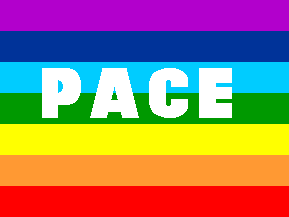 image by M. Schmöger, 2 August 2002
image by M. Schmöger, 2 August 2002
New version
See also:
You might be interested in the peace campaign that has been ongoing in Italy
since early autumn. "Peace from every balcony" is an effort to get people to
show their opposition to war in general and specifically Italian participation
in the US military campaign against Iraq. see www.bandieredipace.org.
It's only in Italian but basically the idea is to fill the cities
of Italy with the rainbow flag.
As far as I know, the version with the white stripe was the
original from the early 1990's. You don't see this much anymore.
You can see the current version above.
David Macdonald, 21 January 2003
The version most commonly used has only seven row. The
"absent" row is the white one. It is often called the
"bandiera arcobaleno" (rainbow flag).
Sergio Frosini, 26 February 2003
I've seen a lot of Italian pacifist flags watching TV (e.g.
the great March for Peace in Rome) or just driving around
Florence. Some of these flags have a white stripe above: I think
they are the oldest ones: the new flags sold by municipalities
and NGO are identical to the one above. However, there are a lot
of variations: apart from the "latest model": a very
common pacifist flag is similar to the Previous
Flag with the white upper stripe, but it often lacks the
white stripe and has got (usually) a thicker lettering (like that
of the above flag). These flags are now used by some 15% of
Italian population, to show their opposition to the war against
Iraq.
There have been also polemics about the similarity of this flag
with the rainbow-"Gay Pride" one. Some Traditionalist
Catholics blame that they are almost identical and good Catholics
should not use it. An Italian gay leader, Franco Grillini, has
said that the pacifist flag was created before the
"rainbow-"Gay Pride" one, as it was first used in
1961 by Aldo Capitini, leader of the Italian non-violent
movement.
Paolo Montanelli, 26 February 2003
I am involved in the campaign "Peace from every
balcony" and personally distributed some hundreds of rainbow
flags. In almost all the cities and towns in Italy there are
peace flags fluttering from the balconies. It is a very popular
campaign: for instance, in the city I live (Pioltello, near
Milan) there are 15.000 families and 2.000 peace flags ! It is
estimated that in the whole Italy there are at least 500.000
peace flags at the balconies. It is the first time in the Italian
history that so many flags are exposed by private citizens.
I also inform you that there are TWO patterns of the Italian
pacifist rainbow flag. One pattern is: blue, azure, violet, green,
yellow, orange, red; PACE is over violet and green. The other
pattern is: violet, blue, azure, green, yellow, orange, red. The
writing PACE covers azure and green. The second one is more
common and also is more like a true rainbow. The other patterns
shown in your page (as Previous Flags) are not
currently used.
Giuseppe Bottasini, 28 March 2003
At peace demostrations this week in Munich (24/27/29 March), I noted a PACE
flag as a "vexillum" (see www.smev.de/2403),
and a PACE flag as a over-skirt (see www.smev.de/2903).
M. Schmöger, 31 March 2003
This morning, driving around my town near Florence, I've seen some flags
matching the pattern seen at the lower flag above, maybe with a slightly darker
violet and a lighter deep blue as the two upper colours. So, it cannot be
considered incorrect, even if the pattern in the upper flag above which can be
seen at italy.peacelink.org
is more frequent.
Paolo Montanelli, 2 May 2003
The newer version, as of years 2001-2002 - The description of
the flag is as follows: seven horizontal stripes of identical
size, one for each of the seven colours of the rainbow, namely
(from top to bottom) purple, blue, cyan, green, yellow, orange
and red. The word "PACE" (peace) is spelt in bold white
capital letters, over the third and fourth stripes. Some early
versions of the flag had the first and third stripes (i.e. purple
and cyan) reversed, so that the white letters would make a
sharper contrast, but this was abandoned in favour of the regular
sequence of rainbow colours. The flag is only produced in the
Italian version; seldom, specimens with the English word
"PEACE" are seen. The flag is currently flown all over
Italy and Switzerland, and has become rather popular in most
other countries too. The alleged plagiarism initially claimed by
the Gay Movement, due to the similarity of their own flag, is
only apparent; the peace flag has seven stripes, whereas the
other one has six, in reversed order (from the top: red, orange,
yellow, green, blue, purple; cyan is missing), and it does not
have a text. The standard size of the present peace flag is 130 x
100 cm.
Andrea Pollett, 3 June 2004
I located the original "Italian pacifist flag" used
by the non-violent leader Aldo Capitini in the March for Peace in 1961 at www.comitatopace.it.
The text is in Italian: here is an English version:
"The first Peace flag is now in Collevalenza, near Todi
(town in Central Italy) kept by dr. Lanfranco Mencaroni, a
friend, jail-fellow and collaborator of the pacifist philosopher
Aldo Capitini, who invented the March for Peace Perugia-Assisi
(the town where St. Francis lived).
The flag was first shown during the first March for Peace,
September 24, 1961. It was inspired by the flag of Anglo-Saxon
pacifists who marched in Aldermaston for an anti-nuclear protest,
led by Bertrand Russell. Mr. Capitini asked some housewives from
Perugia, who were friends of him, to sew with all possible speed
some coloured stripes to form a flag to be shown during the
march.
In the story of the Flood, God puts the rainbow as a seal of his
alliance with humans and nature, promising that will never be
another Flood. So the rainbow became the symbol of peace between
the Earth and Heaven, and, in consequence of that, among all
mankind.
The colours of the rainbow are also used as sign of "unity
in difference" for their physical characteristic of becoming
white if they are wheeled quickly.
The same definition of "Peace symbol" given to the flag
can date back to the Greek word "syn-ballo" which means
"to put together", like the rainbow which puts together
everything and everybody.
Moreover, these colours (only five) can be found also in
"the flag of the races", used by the Civil Rights
society founded by the democratic Afro-American leader Jesse
Jackson.
The Peace flag was used widely in the 80's during the Peace
marches and all Italian demonstrations, as well as in peace
initiatives by Italian volunteers abroad (in Sarajevo, in Iraq,
in Kosovo, in the Democratic Republic of Congo).
Since September 2002, the Peace flag became the symbol of the
campaign "Pace da tutti i balconi" (= Peace from every
balcony) which gained great success in Italy: hundreds of
thousands people show the flag from balconies and window-sills to
say "no!" to the conception of preventive war and to
war in Iraq".
Paolo Montanelli, 1 March 2003
1)![[8 color Pacifist flag in Italy]](../images/i/it}pace.gif) image by António Martins, 14 May 1999
image by António Martins, 14 May 1999
It's a very used flag in Italy, mainly fluttered by
left-oriented and/or catholic pacifist movements. It has eight
horizontal strips, from to bottom: white, dark blue, blue, azure,
green, yellow, orange and red. Over the two central strips
there's the white writing PACE ("peace" in
Italian).
Giuseppe Bottasini
2)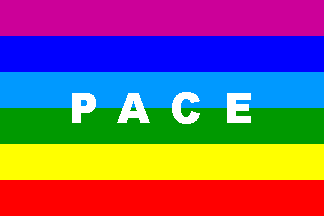 image by António Martins, 27 September 2001
image by António Martins, 27 September 2001
I have a photo of this flag hoisted in demonstration calling
for peace in Butembu (Kivu, Democratic republic of Congo). Flag
in photo is SIX-striped (and not eight-striped) starting above with
the color purple, and following (to below) with blue, light blue,
green, yellow and red (upper white stripe and lower orange
stripe are missing). Letters PACE in white are in the light blue
and green stripes. Is it a simplified version or is it a
different flag?
Jaume Ollé, 7 July 2001
It seems to be a variation of the same flag -- rainbow flags
often have not fixed number nor order of stripes. If you are
curious about what a flag with Italian words is doing in Kongo-Z,
I'd bet it related to the Combonian missionaries, an Italian
order.
António , 27 September 2001
3) 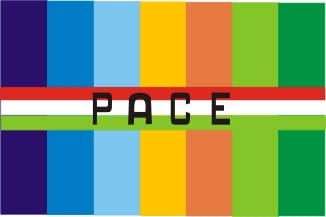 image by Jaume Ollé, 27 March 2005
image by Jaume Ollé, 27 March 2005
Flag used in the 1960.
Jaume Ollé, 27 March 2005
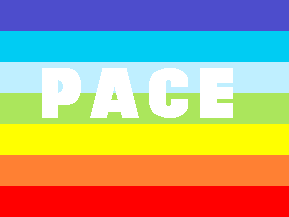 image by M. Schmöger, Tomislav Todorovic
and Mladen Mijatov, 3 June 2005
image by M. Schmöger, Tomislav Todorovic
and Mladen Mijatov, 3 June 2005
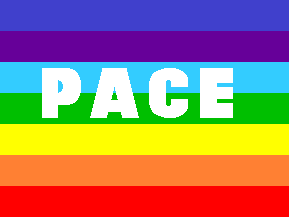 image by M. Schmöger, Tomislav Todorovic
and Mladen Mijatov, 3 June 2005
image by M. Schmöger, Tomislav Todorovic
and Mladen Mijatov, 3 June 2005
 image by M. Schmöger, Tomislav Todorovic
and Mladen Mijatov, 3 June 2005
image by M. Schmöger, Tomislav Todorovic
and Mladen Mijatov, 3 June 2005
Issue #708 (published on 2004-07-02) of Croatian magazine
"Globus" (ISSN 0353-9903) contained a long text about
Veronica Berlusconi, wife of current Italian prime minister
Silvio Berlusconi. On page 104, there was a separate sub-article
titled "A Voice Against the Husband" (Croat: "Glas
protiv supruga"), describing how political opinions of Mrs
Berlusconi often differed from those of her husband, especially
about the Italian military presence in Iraq, which she opposed.
As an illustration, there was a photo from some anti-war protests
in Italy (time and place not mentioned, Mrs Berlusconi not shown
there), showing numerous PACE flags, three of which were clearly
visible and could be identified as versions different from the
previously described ones:
The closest to the photographer, in the central left part of the
photo, there was a large flag with the following colour pattern:
dark blue, light blue, very light blue, green, yellow, orange and
red; white word PACE was over very light blue and green (upper
image above). This resembles a bit the original version of the
flag, but omits the top white stripe; also, dark blue is lighter
here and inclines a bit towards the violet-blue, light blue is
very similar to Zircon Blue from the flag of Sabah, Malaysia - perhaps inclines a bit
more towards the cyan - and very light blue is a bit darker than
Icicle Blue from the flag of Sabah; green is much lighter and
orange is a bit darker than on the other PACE flags.
On some distance behind the previously described flag, in the top
left part of the photo, there was a flag with the following
colour pattern: dark blue, purple, light blue, green, yellow,
orange and red; white word PACE was over light blue and green
(see second image above). Here, dark blue is a bit darker than on
the previously described flag and does not incline towards the
violet-blue, purple is FIAV colour P or very close, while green is
a bit lighter than on the other PACE flags and orange is the same
as on the previously described flag.
Far behind two previously described flags, in the top right
corner of the photo, there was a flag, looking small due to the
distance, but with clearly visible colour pattern: purple, dark
blue, light blue, green, yellow, orange and red; white word PACE
was over light blue and green (see bottom image above). Here,
purple and orange are the same as on the previously described
flag, while dark blue and green are darker than elsewhere.
The colours not mentioned in these descriptions are the same as
on the other PACE flags.
There were many other flags on the photo, but they were either
too distant or not unfurled completely, so they were not clearly
visible. Still, it could be seen that some of them were charged
with word PACE in a typeface different than elsewhere, while the
colour patterns were mostly like those of the three flags
described here.
Tomislav Todorovic, 3 June 2005
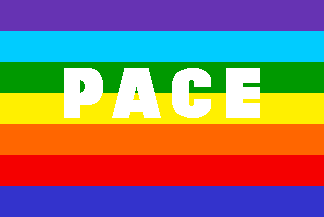 image by M. Schmöger and Tomislav Todorovic,
8 January 2010
image by M. Schmöger and Tomislav Todorovic,
8 January 2010
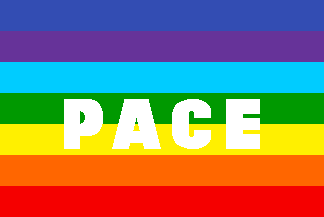 image by M. Schmöger and Tomislav Todorovic,
8 January 2010
image by M. Schmöger and Tomislav Todorovic,
8 January 2010
A new variant of the flag was used in Rome, on 26 February
2006. The colour pattern was: purple, light blue, green, yellow,
orange, red, dark blue; word PACE was inscribed in white over
green and yellow. Numerous copies of this and other variants of
the flag were sewn up together and carried by the participants of
the manifestation, as can be seen on flickr here, here, here
and here.
The same flag appeared again in Milan, on 2007-04-25, where it
was used in the same way as seen on flickr here
and here.
Nice close-up of the flag, but with no place of picture taking,
can be found on flickr here.
It also appeared at a manifestation organized by the Party of
Italian Communists on 20 October 2007 as seen here
and here.
Another variant of the flag was seen in Milan, on 12 October 2003
as seen here.
The colour pattern was: dark blue, purple, light blue, green,
yellow, orange, red; word PACE was inscribed in white over green
and yellow. Note that the inscription is closer to the bottom
edge here than on the other flag variants described so far.
Tomislav Todorovic, 8 January 2010
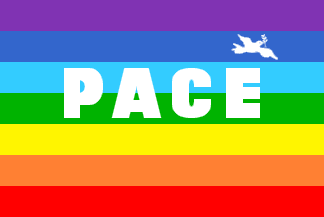 image by M. Schmöger and Tomislav Todorovic, 3 January 2016
image by M. Schmöger and Tomislav Todorovic, 3 January 2016
A peace dove symbol is sometimes added to the PACE flags. Examples of this
were photographed in Trieste, on 2007-07-10:
https://www.flickr.com/photos/labottegadikitphoto/774726635/ and in Milan,
on 2007-10-20:
https://www.flickr.com/photos/bolerosanchez/1991488435/.
The color
pattern was: purple, dark blue, light blue, green, yellow, orange, red. Word
PACE was inscribed in white over light blue and green and a white peace dove was
placed on dark blue stripe, above the letter E. It shall be noted that the flag
from Trieste seems to have been double-sided, with different inscriptions on the
other side and positioned differently as well, but the photo does not reveal
many details.
Tomislav Todorovic, 3 January 2016
 image by M. Schmöger and Tomislav Todorovic,
3 January 2016
image by M. Schmöger and Tomislav Todorovic,
3 January 2016
A discussion on numerous variants of Italian peace flag, from a designer's
point of view, was posted on the Web by Danish artist Kim Wyon in late 2009 or
early 2010. The page, no longer online, can be viewed at the Internet Archive:
http://peace-flags-of-pisa.dk/design.html and is illustrated with numerous
photos, taken mostly in Pisa, with a few examples from other cities. Many photos
were displaying the flags with well-known patterns, although the color shades
may have varied somewhat, but there were also the examples of the patterns which
seem to have been presented on the Web for the first time.
The flag with
what could be the most unordered pattern of rainbow colors so far was
photographed in Genoa (photo:
http://peace-flags-of-pisa.dk/thumbsflag/7a-peaceflag.jpg).
The color
pattern was: red, dark blue, light blue, violet, green, yellow and orange; white
word PACE was placed over violet and green.
Tomislav Todorovic, 3 January 2016
 image by M. Schmöger and Tomislav Todorovic,
3 January 2016
image by M. Schmöger and Tomislav Todorovic,
3 January 2016
The flag presented with the biggest number of photos:
photo 1:
http://peace-flags-of-pisa.dk/thumbsflag/9a-peaceflag.jpg
photo 2:
http://peace-flags-of-pisa.dk/thumbsflag/university-2.jpg
photo 3:
http://peace-flags-of-pisa.dk/thumbsflag/shadow.jpg
photo 4:
http://peace-flags-of-pisa.dk/thumbsflag/peaceflag-c1.jpg
has the color
pattern: violet, turquoise, light blue, green, yellow, orange and red; word PACE
is inscribed in white over light blue and green. This is very similar to a flag
already seen in Croatian magazine "Globus" (ISSN 0353-9903), issue #708 of
2004-07-02, but with violet (inclining somewhat towards a grayish dark blue) and
turquoise instead of dark blue and light blue, respectively, also employing
darker yellow and lighter orange, only (very) light blue, (light) green and red
looking the same on both flags. Replacing dark blue with turquoise or cyan,
placed between a bluish violet (or dark blue) and a very light blue, is a
widespread tendency in other countries, like the UK
or the USA but has obviously reached Italy as well.
Tomislav Todorovic, 3 January 2016
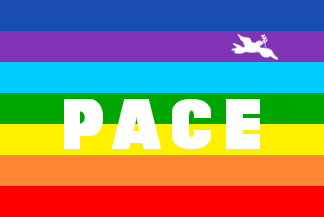 image by M. Schmöger and Tomislav Todorovic,
3 January 2016
image by M. Schmöger and Tomislav Todorovic,
3 January 2016
Rainbow peace flags with different patterns may be charged with an additional
peace dove. Such a flag was spotted in Pisa by Kim Wyon, too. The color pattern
was: dark blue, purple, light blue, green, yellow, orange, red. White word PACE
was inscribed over green and yellow and a white peace dove was placed on purple
stripe, above the letter E.
Tomislav Todorovic, 3 January 2016
 image by M. Schmöger and Tomislav Todorovic,
3 January 2016
image by M. Schmöger and Tomislav Todorovic,
3 January 2016
On a number of flags, the inscription is centered on the field, thus
overlapping three stripes instead of two. A different typeface is also used -
Microgramma,
an Italian-designed typeface, in bold extended variant. Such a flag was already
seen in 2004 on the photo from "Globus" magazine, but was both too distant and
incompletely displayed, so it was not possible to reconstruct the color pattern,
although the typeface was still recognizable due to the contrast of white
letters and dark background. In Pisa, Kim Wyon saw three such flags. One of
these (photo:
http://peace-flags-of-pisa.dk/thumbsflag/peaceflag-28.jpg) was with the
following color pattern: purple, dark blue, light blue, green, yellow, orange,
red; word PACE in white, fimbriated dark blue, was placed over light blue, green
and yellow. Another feature of the flag was a rather dark shade of red.
Tomislav Todorovic, 3 January 2016
 image by M. Schmöger and Tomislav Todorovic,
3 January 2016
image by M. Schmöger and Tomislav Todorovic,
3 January 2016
Another such flag (photo:
http://peace-flags-of-pisa.dk/thumbsflag/peace-flag40.jpg) follows the trend
of replacing dark blue with turquoise or cyan, with the following color pattern:
violet, cyan, light blue, green, yellow, orange, red; white word PACE,
fimbriated cyan, was placed over light blue, green and yellow. The pattern
combined dark violet (inclining towards indigo), dark cyan (not much different
from teal), very light shades of green and light blue, visibly dark yellow and
red and a rather dark orange.
Tomislav Todorovic, 3 January 2016
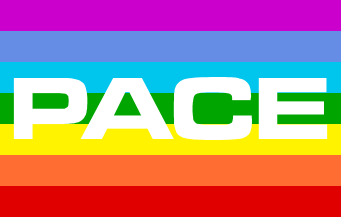 image by M. Schmöger and Tomislav Todorovic,
3 January 2016
image by M. Schmöger and Tomislav Todorovic,
3 January 2016
The third of these flags (photo:
http://peace-flags-of-pisa.dk/thumbsflag/25a-peaceflag.jpg) has employed
essentially the same color pattern as the first one, but with a medium violet
(inclining towards magenta), dark blue inclining towards a medium shade of
violet-blue and visibly darker shades of all other colors, yellow having been
the least so.
Tomislav Todorovic, 3 January 2016
 image by M. Schmöger and Tomislav Todorovic,
3 January 2016
image by M. Schmöger and Tomislav Todorovic,
3 January 2016
Lastly, the third typeface (Helvetica) was seen in Venice (photo:
http://peace-flags-of-pisa.dk/thumbsflag/peace-flag-31.jpg) on an
eight-striped flag with an additional white stripe, similar to early peace
flags.
The color pattern of this flag was: white, indigo, cyan, light
blue, green, yellow, orange, red; word PACE was inscribed in white over light
blue and green. The pattern featured a very light blue and rather dark orange
and red.
Tomislav Todorovic, 3 January 2016
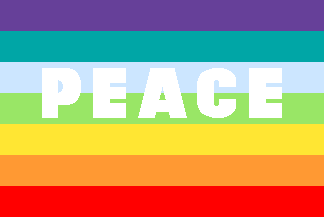 image by M. Schmöger and Tomislav Todorovic,
16 January 2016
image by M. Schmöger and Tomislav Todorovic,
16 January 2016
The flag is almost invariably charged with the Italian inscription. The only
photos of variants with the English inscription PEACE were posted on the Web by
Danish artist Kim Wyon in late 2009 or early 2010 as part of his discussion of
different variants of Italian peace flag from a designer's point of view. The
page, no longer online, can be viewed at the Internet Archive:
http://web.archive.org/web/20110824051131/http://peace-flags-of-pisa.dk/design.html
and displays photos of three flags with the inscription PEACE which were
photographed in the city of Pisa.
The first of these flags (photo:
http://peace-flags-of-pisa.dk/thumbsflag/peaceflag-29.jpg) is almost
identical with one of those with the Italian inscription, with the following
color pattern: violet, cyan, light blue, green, yellow, orange and red; word
PEACE is inscribed in white over light blue and green. On this flag, the top two
stripes seem to be darker than on the flag with Italian inscription.
Tomislav Todorovic,
16 January 2016
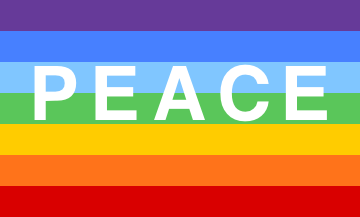 image by M. Schmöger and Tomislav Todorovic,
16 January 2016
image by M. Schmöger and Tomislav Todorovic,
16 January 2016
The second flag (photo:
http://peace-flags-of-pisa.dk/thumbsflag/peaceflag-27.jpg) employs
Helvetica, a typeface seldom used on these flags. The color pattern is: dark
violet, medium blue, light blue, green, yellow, orange and red; white word PEACE
is placed over light blue and green. Violet colors inclines somewhat towards
indigo and yellow, orange and red are visibly darker than on most of other flag
variants.
Tomislav Todorovic,
16 January 2016
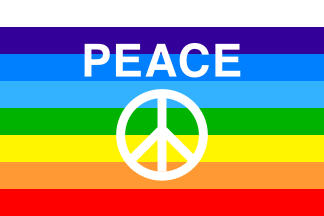 image by M. Schmöger and Tomislav Todorovic,
16 January 2016
image by M. Schmöger and Tomislav Todorovic,
16 January 2016
Lastly, word PEACE appears, together with a peace sign, on an eight-striped
flag which adds white to the rainbow colors, similar to early peace flags. On
this flag (photo:
http://peace-flags-of-pisa.dk/thumbsflag/16a-peaceflag.jpg) the color
pattern is: white, dark blue (indigo), medium blue, light blue, green, yellow,
orange, red; word PEACE is inscribed in white over dark and medium blue stripes,
larger part over medium blue; white peace sign is placed over light blue, green,
yellow and orange, in center of the area comprising these four stripes. The
shades of medium and light blue actually seem rather close to each other in
terms of luminosity.
Tomislav Todorovic,
16 January 2016
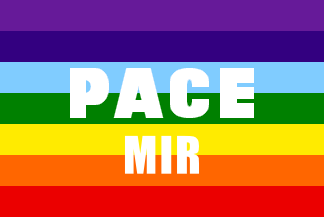 image by Tomislav Todorovic,
11 June 2017
image by Tomislav Todorovic,
11 June 2017
A variant with the word for "peace" inscribed in two/three languages was
photographed in Trieste in August 2011, at a meeting held during the
preparations for the Concert for Peace, an event which takes place every year in
the town of Sgonico (/Zgonik/ in Slovene), in the province of Trieste and
gathers youth from Italy, Slovenia and Croatia. The flag was shown as spread
over the table around which the meeting participants were sitting; although it
was partly covered by the printed documents used by the sitters, it was still
possible to recognize the color pattern and both inscriptions. The color pattern
was: purple, dark blue, light blue, green, yellow, orange, red. Both
inscriptions were in white, word PACE over light blue and green and its
Slovene/Croat counterpart MIR (it is the same in both languages) over yellow and
orange. The photo can be viewed here:
http://test.primorski.it/stories/trst/195911/#.WT1Yabj0_To (image:
http://media.primorski.eu/media/2011/08/23395_294103_110830db04_2810765_medium.jpg).
Tomislav Todorovic,
11 June 2017
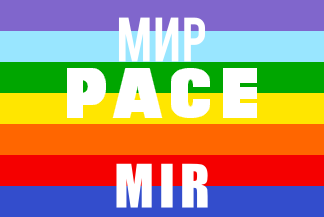 image by Tomislav Todorovic,
11 June 2017
image by Tomislav Todorovic,
11 June 2017
Another variant, with the word for "peace" inscribed in Italian, Slovene and
Russian was also photographed in Trieste in August 2011, at the wedding of a
leftist activist from Trieste, an ethnic Slovene, and his Russian bride. The
groom was the head of the Trieste Partisan Singing Choir "Pinko Tomažič" and
most of the wedding guests shared the newlyweds' political affiliation, so
several Yugoslav Socialist-era flags were brought to the event, together with a
peace flags with the inscriptions in Italian, Russian and Slovene. The color
pattern of this flag was: violet, light blue, green, yellow, orange, red and
dark blue. The inscriptions were all in white, word PACE over green and yellow,
word МИР over violet and light blue, set next to the top edge
of green, and word MIR over red and dark blue. The photo can be viewed here:
http://www.primorske.si/Zanimivosti/Titovska-svatba-sredi-Trsta.aspx (image:
http://static.primorske.si/foto/highres/old/dd/dde05b76-929b-4530-814e-c9ad33fe3e59.jpg)
Tomislav Todorovic,
11 June 2017
 image by Tomislav Todorovic,
18 June 2023
image by Tomislav Todorovic,
18 June 2023
Another bilingual Italian-Slovene variant exists which also displays the
peace dove. The color pattern is: dark blue, purple, light blue, green, yellow,
orange, red. Both inscriptions are in white, word PACE over green and yellow and
word MIR over orange and red. The peace dove in white is placed on the purple
stripe, above the letter E.
Source: Manuela Schmöger's gallery of flag
photos:
http://kommunalflaggen.eu/index.php?title=Datei:POL_IT_pace-mir-ms1.jpg
Tomislav Todorovic,
18 June 2023
 image
by António Martins, 5 April 2005
image
by António Martins, 5 April 2005
Another Italian peace flag
can be seen at www.sistemia.it/pace.
Dov Gutterman, 4 September 1999
This shows on a blue background a stylized version of the peace-sign consisting the ring around it
of two flag like ribbons (horizontal tribands: yellow - blue -
green on the hoist side, and yellow - black - red on the fly
side), completed by groups of figures representing children from
several ethnic groups at the bottom. On the bottom hoist corner
the lettering "Bandiera della Pace" (Italian for
"flag of peace"), and on the bottom fly "Peace's
flag", both in white letters.
António Martins, 27 September 2001
Hosted by: Fanshop-Online.de und Handy-Shop.de
Tipp: Apple iPhone 15 im Shop